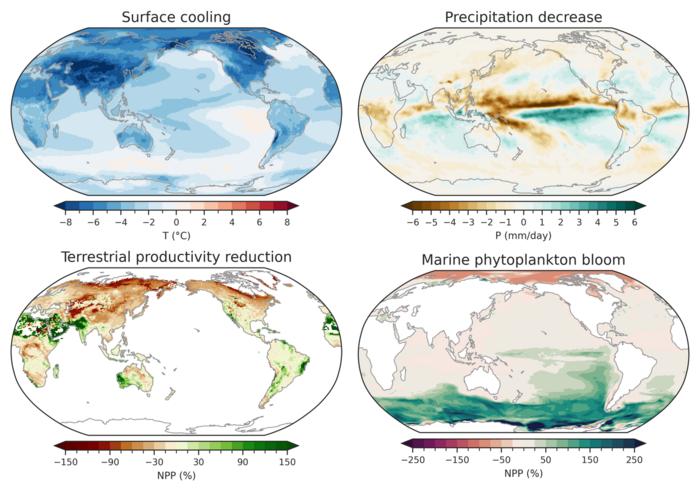Imagine a fiery streak across the sky, ending not with a whimper but a catastrophic BANG. That’s the chilling image an asteroid impact paints, a cosmic event capable of rewriting the story of life on Earth. From dinosaurs to modern civilizations, our planet has weathered its share of cosmic storms. But what happens when another celestial wanderer enters our neighborhood? Buckle up, because we’re about to explore the physics-bending consequences of an asteroid strike, the devastation it could unleash, and the potential for our survival.
Blast Radius: The Physics Behind the Initial Explosion and Its Devastating Effects
The Immediacy of Impact

An asteroid impact is an event of unimaginable power, releasing an explosive energy that dwarfs even the most powerful nuclear weapons. The initial blast radius, the area directly affected by the shockwave, is determined by the asteroid’s size and velocity. A small asteroid, like the one that flattened the Tunguska region of Siberia in 1908, might create a blast radius of several kilometers. However, a larger asteroid, like the one that wiped out the dinosaurs 66 million years ago, could unleash a blast radius spanning hundreds of kilometers.
Seismic Tremors
The impact’s energy doesn’t just radiate outward as a shockwave; it also reverberates through the Earth’s crust, triggering earthquakes of unimaginable magnitude. These earthquakes can be felt across entire continents, causing widespread damage to buildings, infrastructure, and landscapes. The severity of the earthquake depends on the asteroid’s size, depth of impact, and the geology of the region.
Tsunamis Unleashed
If the asteroid strikes an ocean, the impact generates enormous tsunamis that can travel thousands of kilometers across the globe. These towering waves, sometimes hundreds of meters high, can inundate coastal regions, causing catastrophic damage and loss of life. The tsunami’s force can reshape coastlines, destroy entire cities, and leave lasting scars on the planet’s geography.
Scorched Earth: The Immediate Aftermath and Widespread Damage Caused by Heat and Shockwaves
A Fiery Inferno
The initial impact creates a searing fireball that instantly vaporizes anything in its path. This fireball, reaching temperatures hotter than the surface of the sun, can ignite massive wildfires that rage across vast areas, consuming forests, grasslands, and urban centers. The intense heat also causes widespread thermal damage, melting infrastructure, and turning land into barren wastelands.
Shockwaves Rippling Out
The shockwaves generated by the impact travel outward at supersonic speeds, flattening everything in their wake. These shockwaves can shatter windows, topple buildings, and uproot trees, leaving behind a trail of devastation. The force of the shockwaves can extend for hundreds of kilometers, leaving a permanent mark on the landscape.
Life in the Shadows: The Long-Term Consequences for Life
Photosynthesis Shutdown: The Impact on Plant Life and the Resulting Decline in Global Food Production
An asteroid impact would send a shockwave through the Earth’s delicate balance, particularly impacting plant life and the global food supply. The massive dust cloud ejected into the atmosphere would block sunlight, disrupting photosynthesis, the process by which plants convert light energy into chemical energy. This disruption would lead to a significant decline in terrestrial net primary productivity (NPP), the rate at which plants convert sunlight into biomass. A study published in Science Advances by researchers at the Institute for Basic Science (IBS) Center for Climate Physics (ICCP) projected a decrease in terrestrial NPP averaging over the first 24 months following a Bennu-sized asteroid impact. This decline in plant growth would have devastating consequences for food production, threatening global food security.
Marine Ecosystems Under Pressure
The ocean, home to a vast and intricate web of life, would also suffer significant consequences from an asteroid impact. While diatoms, a type of phytoplankton, might initially thrive due to iron-rich dust from the impact sinking into the ocean, the overall health of marine ecosystems would be severely impacted. The dust cloud would reduce sunlight penetration, affecting photosynthesis in marine plants and disrupting the delicate balance of the food chain. A study by the ICCP projected an average decrease in marine NPP from 10 to 38 months after the impact. This decline could lead to mass die-offs of marine organisms, impacting fisheries and coastal communities that rely on the ocean for sustenance and livelihood.
A World Transformed: Imagining the Long-Term Ecological and Societal Consequences of a Major Asteroid Impact
The long-term consequences of a major asteroid impact extend far beyond immediate environmental devastation. The altered climate, disrupted ecosystems, and widespread food shortages would have profound societal ramifications. Global populations would face unprecedented challenges in adapting to a drastically changed world. Conflicts over dwindling resources, mass migrations, and social unrest could become commonplace. The very fabric of human civilization would be tested as we grapple with the consequences of an event that could reshape our planet in unimaginable ways.
Bennu’s Shadow: Assessing the Risk and Preparing for the Worst
The Bennu Threat: Understanding the Potential for a Near-Earth Asteroid Collision and the Scale of the Risk
Bennu, a near-Earth asteroid with a diameter of approximately 500 meters, poses a credible threat to Earth. While the probability of a collision is relatively low, estimated at 0.037% in September 2182, the potential impact would be catastrophic. A Bennu-sized asteroid impact would release a tremendous amount of energy, causing widespread devastation and triggering a global climate crisis. The consequences, as outlined by the ICCP study, would be similar to those experienced after some of the largest volcanic eruptions in Earth’s history, highlighting the scale of risk associated with this celestial object.
Deflection Strategies: Exploring Technological Solutions to Mitigate the Threat of Asteroid Impacts
Recognizing the potential danger posed by asteroids like Bennu, scientists and engineers are actively developing strategies to deflect them from potential collision courses with Earth. These strategies involve a variety of approaches, each aiming to alter the asteroid’s trajectory or reduce its impact energy. Some proposed methods include:
- Kinetic Impactor: A spacecraft would collide with the asteroid, transferring momentum and slightly changing its course.
- Gravity Tractor: A spacecraft would use its own gravity to gradually pull the asteroid off its trajectory.
- Nuclear Option: A nuclear explosion near the asteroid could nudge it off course, although this method carries significant risks.
While these deflection strategies are still in the development phase, they represent a crucial step towards mitigating the threat posed by asteroids and safeguarding our planet.
Cosmic Vigilance: The Importance of Continuous Asteroid Monitoring and International Collaboration in Space Exploration
Continuous monitoring of near-Earth objects (NEOs) like Bennu is essential for detecting potential threats and providing ample time for response. International collaboration plays a vital role in this endeavor, allowing for the sharing of data, expertise, and resources. Programs such as NASA’s Planetary Defense Coordination Office and the European Space Agency’s Near-Earth Object Coordination Centre (NEOCC) are dedicated to tracking NEOs and developing strategies to mitigate potential impacts. Investing in space exploration, asteroid detection, and deflection technologies is a critical step in ensuring the long-term safety and sustainability of our planet.
Conclusion
The potential impact of an asteroid strike on Earth is a sobering reminder of our planet’s vulnerability. As Physics World’s article elucidates, the consequences could range from localized devastation to global cataclysm, depending on the asteroid’s size and trajectory. The immense energy released upon impact could trigger earthquakes, tsunamis, and widespread fires, while the resulting dust cloud could block sunlight, plunging the planet into a prolonged period of darkness and frigid temperatures. This sobering reality underscores the importance of continued asteroid detection and monitoring programs. By identifying potential threats early on, we can develop mitigation strategies, such as deflecting the asteroid or preparing for its impact. While the prospect of an asteroid strike may seem distant, the potential consequences are too profound to ignore. The future of life on Earth may depend on our ability to remain vigilant and proactive in safeguarding our planet from these celestial hazards. The cosmos may hold wonders, but it also harbors dangers. Are we prepared to face them?



Add Comment